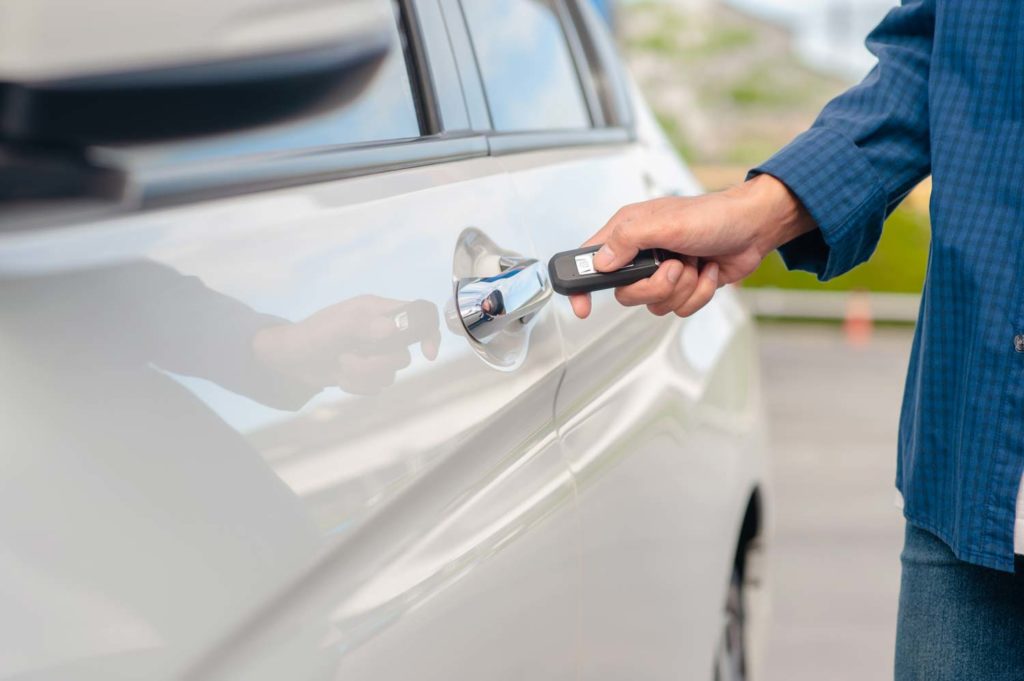These days, most thieves have moved beyond the hotwiring you might see in an action movie. Modern cars have a transponder chip in the ignition key that must match the car to start it. Keyless or keyed, it seems to be no problem for car thieves; more than one million vehicles were stolen in 2022, a jump from the prior year by 7%. Over the past five years, the number of stolen cars in the U.S. has doubled. Luxury brands like Audi, BMW, Jaguar, Porsche, Tesla, and more are increasingly affected by keyless car theft. But how do thieves steal cars with transponder keys?
In this blog, we’ll look at keyless car theft, its causes, and some solutions. How do people steal cars? Which keyless cars are the most stolen? What are the best ways to ensure keyless fob security? Let’s answer these questions and more.
In the movies, it looks like it takes a couple of minutes for an experienced thief to smash a car window and hotwire a car. But experienced criminals are looking for opportunity, access, and an easy target.
Once cars began using electronic keys, criminals learned an easier method over the old smash and grab; just steal the key. Thieves can steal keys left in mounted lock boxes at car dealerships. If they’re clever, they may be able to just snag the key off the wall. Criminals can also break into the boxes with a bolt cutter after hours. Thieves can steal keyless cars using various techniques that also exploit vulnerabilities in the keyless entry and ignition systems technology, too.
“If a thief has the right knowledge and equipment, modern cars can be incredibly easy to steal, and stealing them is actually getting easier rather than harder. The very technology that was supposed to make cars more secure is actually making life easier for criminals.”
Let’s look at all the issue of keyless car theft and how you can prevent it.
How Do Keyless Cars Work?
To fully understand best practices for keyless car theft prevention, it helps to understand how keyless entry systems work. Modern vehicles equipped with keyless ignition use radio signals transmitted between the car and the key fob. When the key fob is within a certain proximity, typically a few feet, the car unlocks and allows the engine to start — all without pressing a button.
While this technology is undeniably convenient, it opens the door to new types of theft. Criminals have developed techniques that exploit the radio frequency communication between the fob and the vehicle, often without even touching the car.
The problem lies not with the locks or alarms themselves, but with how easily the signal can be intercepted or extended using inexpensive, readily available tools.
The Trouble with “Keyless” Cars (That Have Transponder Keys)
What makes keyless car theft so dangerous is that it often doesn’t leave visible signs of forced entry, making it harder for insurance companies to verify that a theft occurred. Understanding how thieves steal key fob signals is essential for crafting a layered defense.
Today, thieves don’t have to overcome a lot of obstacles in the car itself to steal it. They can simply use the programmed signal from the car’s keyless entry fob. But how do they get that signal?
If the keys lack a signal-blocker shield (called an RFID blocker), thieves can use a transponder device, which you can pick up online on the cheap. That electronic device can capture the keyless entry code as it’s sent from the fob to the car. They can use that captured signal to open the car door with no alarm, start it, and drive away. It basically tricks the car into thinking the key is nearby. This technique is also known as key cloning. No matter what you call it, it’s an attractive way for criminals to take advantage of modern technology and turn it against us.
This technique has now combined with something called “relay theft.” Relay thieves work in pairs. The thieves use a transmitter device. One thief stands by the car with the transmitter. The other goes near the dealership to try to pick up a signal from a key that’s hanging from the lockbox.
In commercial settings, this is especially dangerous. Key fobs stored too close to exterior walls, left unattended near service desks, or even inside metal lockers can be vulnerable. Thieves can perform these attacks in under a minute, and in high-turnover environments like dealerships, thefts may go unnoticed until inventory checks.
There’s also a technique used to steal keyless cars called signal jamming. Thieves use devices that emit radio signals to block the communication between the key fob and the car. When the owner presses the lock button on the key fob, the signal is jammed, preventing the car from locking. If you’re not paying attention, you walk away thinking everything is fine. The thief can then gain access to the unlocked vehicle.
Some thieves exploit vulnerabilities in the car’s onboard diagnostic port (OBD port) to connect a programming device. By reprogramming a blank key fob, they gain access to the car and can start it with this duplicate key.
Another technique is to hack the car’s immobilizer system. Keyless cars use this system to prevent the engine from turning over without the correct electronic key. Skilled hackers can exploit vulnerabilities in the car’s immobilizer system software to bypass or disable this feature and start the vehicle.
Stealing a car today is easier than it’s ever been. Even worse is the fact that keyless car theft is increasing. A study in late 2022 showed that keyless cars are actually twice as likely to be stolen as older cars with traditional keys.
When coupled with the expertise of serious, experienced criminals, car dealerships have a lot to worry about. Fortunately, there are a variety of methods to stop criminals in their tracks.
What Makes Commercial Lots a Prime Target?
Places like parking lots and dealership yards present unique vulnerabilities:
Asking – and understanding – the question “how do thieves steal key fob signals?” helps commercial operators assess their own exposure and plan accordingly.
How to Prevent Keyless Car Theft at Your Auto Dealership
Making your lot less attractive to thieves is and should always be a top priority. If you make it harder for criminals to steal car parts or the car itself, they will look for other, less attractive targets of opportunity. Some of the standard methods and tools for preventing theft at an auto dealership include:
See How Simple It Can Be To Secure Your Business.
-
Lighting
Having car lots and the dealership fully illuminated is critical. This includes back lots and any secondary lots you may have for extra inventory.
-
Secondary storage
Keep your most expensive vehicles (with pricey parts) inside. Limit access to the dealership's lot and storage areas to authorized personnel only. Use access control measures such as electronic key cards or biometric systems to restrict entry.
-
Wheel locks
Locking the wheels may be a good additional investment for expensive cars that have to remain outside.
-
GPS units
Tracking devices may already be installed on some vehicles. Consider installing immobilizers, GPS tracking devices, or other anti-theft systems on all the vehicles in your inventory. These measures can deter theft and aid in recovery if a theft occurs.
-
Keep dealer plates and keys under lock and key
Don’t use lock boxes on the cars themselves. Store vehicle keys in a secure location, preferably in a locked cabinet or safe. Limit access to the key storage area to trusted employees only, and keep a record of who has access to the keys.
-
Secure the perimeter of your lots
Fencing is a necessity these days. Seal off entrances after hours with trucks or a secure steel gate, so thieves can’t drive in flatbeds. Implement a robust physical security system beyond perimeter fencing, to include surveillance cameras, and well-lit areas. Make sure all entry points, including gates and doors, are secure and monitored. Consider a virtual security guard team to monitor surveillance cameras, watching every angle of your property 24/7/365.
-
Develop security protocols
Train your employees in the rigors of locking down your inventory. Educated dealership staff about keyless car theft techniques and the importance of rigorous security measures. Train your teams on proper key handling procedures, including securely storing and returning keys after use. Follow these best practices every day to the letter.
-
Enforce a strict vehicle sign-out process
Use software or inventory management systems to track and monitor the movement of keys and vehicles within the dealership. This can help identify any discrepancies or potential thefts.
-
Park cars with the e-brakes on and the tires turned in one direction
It’s a small detail, but it will make the car harder to tow away.
-
Audit your protocols and improve them
Criminals are ever-vigilant. You should be, too. Conduct regular audits of your key inventory and vehicle records to identify any discrepancies or missing keys. This will help you detect any potential internal theft or security breaches. Stay informed about the latest security practices and technological advancements in automotive security. Keep in touch with manufacturers and security experts to understand potential vulnerabilities and recommended countermeasures.
-
Collaborate with law enforcement
Develop a relationship with local law enforcement agencies and share information regarding vehicle theft trends or suspicious activities. This collaboration can help prevent theft and aid in the recovery of stolen vehicles.
How Modern Security Cameras Protect a Car Lot
-
Connect wirelessly to the internet
-
Offer automated notifications, sending you a text when there is any suspicious activity
-
Mobile solar-powered cameras can float around your facility for additional protection
Commercial-Grade Keyless Car Theft Prevention Measures
-
Implement after-hours access controls. Use motion-sensitive lighting, gates, and surveillance systems that notify remote agents in real time of potential intrusions.
When deployed together, these steps not only provide key fob theft protection but also strengthen overall lot security against both high-tech and low-tech threats.
As technology continues to evolve, so do the tactics used by criminals. While the convenience of keyless systems isn’t going away, dealerships and lot operators must be proactive. Combining physical deterrents with advanced commercial surveillance is the most effective way to stay ahead of modern threats. Pro-Vigil’s AI-powered monitoring is a force multiplier for any security posture — especially when it comes to keyless car theft prevention
FAQ: Keyless Car Theft
Yes — in many cases, keyless cars are more vulnerable to relay attacks and signal interception, especially if the fob emits signals constantly. However, proactive security measures can mitigate the risk.
Thieves typically use a two-part relay system. One person captures the signal from the key fob inside your office or home, while the other relays it to the vehicle. The car thinks the fob is nearby and unlocks or starts.
Relay devices can capture signals from 30 to 50 feet away — sometimes even more if the signal is strong. This means your keys don't need to be near a door to be vulnerable.
A relay attack uses two signal-boosting devices to trick the vehicle into thinking the key fob is within range. It's one of the most common methods of keyless entry car theft today.
Many newer vehicles offer motion-sensitive fobs, time-limited signals, and encrypted communication. Still, adding physical deterrents like wheel locks and Faraday bags enhances keyless car theft prevention.
Yes — while no system is foolproof, combining digital safeguards with physical deterrents and signal-blocking solutions significantly reduces your risk.









